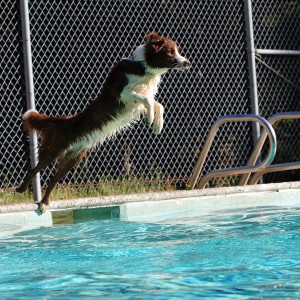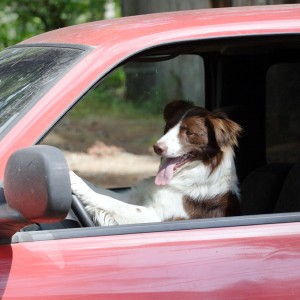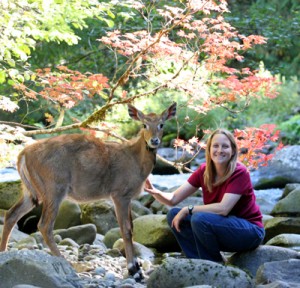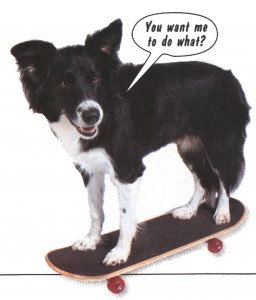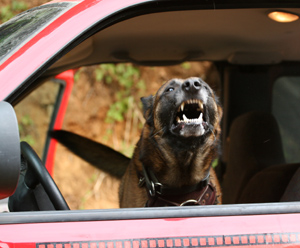One of the first lessons any young animal needs to learn is how and when to use—and not use—his teeth. While various terms and training techniques are utilized, there are essentially two techniques for resolving the issue of biting:
· Bite prohibition—teeth are never used on humans. This school argues that no tooth should ever touch flesh or clothing. The principal advantage is that this is a very clear and simple rule for both the trainer and the animal to understand.
· Bite inhibition—teeth may be used on humans, but only when humans initiate such action, and must be used gently. The principal advantage of this method is that the animal learns that human flesh is weak and that biting should not be hard.
Either of these techniques can be successfully trained with reasonable effort; however, I strongly recommend inhibition unless you do not feel that you can master the timing and training required.
Let me briefly explain why inhibition is the better option: if you observe carnivores in the wild, or in captivity interacting with each other, you will quickly note that they have virtually perfect bite inhibition: they can carry babies, wrestle with friends, cavort with mates, all using their teeth without causing injury. This is one of the deepest and earliest lessons learned by any wild animal—bite your siblings too hard and the fun stops, bite your mom to hard and the food stops. Every wild animal is a master at using his mouth carefully, and this is powerfully instinctive. Conversely, you will virtually never see any animal practice bite prohibition. It simply does not make any sense for an animal to not use his mouth since the mouth represents the primary tool for interacting.
In addition to being more natural, teaching inhibition nurtures a stronger bond. Again, look at wild animals—they routinely mouth and groom the animals with whom they are closest. The only animals they do not touch with their mouths are their enemies.
A strongly inhibited animal is much less likely to bite, and if a bite does occur, it is far less likely to be serious because you have essentially conditioned their brains and bodies to bite gently. Conversely, bite prohibition is a trained rule, and when a strong enough stimulus arises, most animals will disobey a trained rule and the consequences can be dire.
Regardless of which technique you train, do not utilize punishment during the early stages. Punishment is virtually never an ideal tool for teaching—animals learn far faster when encouraged to try the right behavior, but particularly for teaching this lesson, punishment is contraindicated. You start teaching this lesson to animals that are very young, and you work on it so often, that it plays a huge role in setting the tone of your animal’s interaction skills, and if you are using violence your animal will learn that the way to resolve disagreements is through violence. In my experience, most animals that are trained using bite prohibition and repeated corrections eventually become unreliable and potentially dangerous when they are powerful adults.
Teaching Bite Inhibition
Before you begin, remind yourself of a few central notions:
· Patience—this is going to take weeks, and you cannot expect a baby to magically know not to bite. They do not have great behavioral self control nor do they have fine motor skills, so it is a process, not an overnight fix. As they get more mature and you teach them more and more, they will get better and better and hard biting will extinguish.
· Willingness to be mouthed—you may have developed an aversion to ever having teeth touch your skin if you have taught bite prohibition in the past, and you need to reset this expectation. In fact you need to reverse it to the point that you actively seek to have your body used as a gentle toy. If not, you will not successfully reinforce inhibition.
Also before you begin, familiarize yourself with the following adjunct methodologies that will be used in parallel with the training to reinforce the core lessons and to avoid being bitten until the animal has mastered inhibition:
· Displacement—when the animal is mouthy and you are not in the mood to train, have high value toys that you can lure him to play with instead of your hand.
· Feeding—animals often get more mouthy when hungry, so for a long time avoid playing any games when they have not eaten for a while, so you do not set them up to fail.
· Hand feeding—feed as much as you can from your hands, but only feed a calm animal that is listening and doing what is asked, and never let biting get them the food.
· Hand licking—feed peanut butter or squeeze cheese from your hands that he has to gently take from your flesh without biting. If he nips at all, leave (again tie him to something solid so you can just step back).
· Play with teeth and gums and mouth lots—brush teeth, open up mouth and stick in a treat, generally get him used to having your hands in there.
· Restraint game—lie somewhat on top of your animal, not squishing him but bear hugging him, and restrain him until he relaxes. Talk to him calmly and soothingly, but do not let him loose until he relaxes and settle. This may take a while at first, but will get easier each time. Do not release him if he only holds still—wait for him to genuinely relax.
· Calming games—when your animal is already tired in the evening, sit and stroke, him, and if he mouths very gently put a word to it and teach him it is okay to hold your hand in his mouth affectionately while you massage or stroke. You can use this same time to teach him to play dead since you are reinforcing lying still and quiet anyway.
· Never let biting get him anything he wants—if he uses his mouth to correct you, even gently, that never works. Of course, safety first—if you are at risk, end the behavior and get yourself safe and then think about how you are going to address the problem.
Now that you have internalized the secondary techniques, it is time to focus on actually conditioning inhibition:
Step 1. Let your baby play with lots of other juveniles and reasonable adults—animals that will effectively correct any excessive nips. Intentionally pair him with animals that will play, but that will not put up with being bitten hard—some older dogs will correct for this, others will just leave and not play for a while. Both effectively teach the pup limits. Other animals can teach this in a few days where it would take most humans longer, and once your baby has the idea, it will be much easier for humans to impose our limits. Regardless of the species of animal I am training, I will usually let them play with some gentle dogs who are very good models of playing without biting hard.
Step 2. Teach “do not bite humans hard, we are REALLY wimpy.” First make sure he is a little tired and has played with other animals or a toy for a while. You want to set him up to succeed, and not to rehearse the bad behavior. Sit down in a boring area and play with your hand in his mouth as a toy. Immediately start pairing a word to this so he knows there is a cue for this game (try to use a command that sounds better in public then “bite.”) Any time he is too rough, say “ouch” and stop playing. You can have him on leash with the leash attached to something solid so he cannot follow, or just go a few feet away and pout for several minutes. Your goal is to be completely and palpably unstimulating—exude boringness and stillness. Return and make up so he knows that you are not mad and do not love him less– it is merely a consequence of his biting too hard that all play and fun stop. In general, do not correct, it is generally not very effective, and often backfires or at least erodes the pup’s confidence. Timing and awareness are key here—you want to praise and reward gentleness whenever they occur and gradually raise the criteria—react to softer and softer bites until he can play with your hand lots and never bite hard at all. And remember that as you are playing you may praise, but it is really the play that is the reward, so it is soft mouth and energy that perpetuate the play.
Step 3. Concurrent with step two, but in separate training sessions, teach an “off,” “leave it,” or “drop” command. Do this starting with food or a toy in your hand. Say “leave it,” wait till he is not trying to get the reward, then reward him. Sometimes reward with the item he was waiting for, other times with a different reward. Do this several times a day and increase the duration of how long he must “leave it” before getting the reward. Once he understands the static version of this game, start playing with him having a toy and saying leave it and then giving them a reward after the drop the toy. Do this every day, and incorporate tug games, so he really values the toy, but learns to leave it when asked because a better reward is coming. Once he can do this reliably with toys, combine this with step two– play gently with your hand, until you say leave it, then let go and get a treat. Be sure to give a command for playing with your hand, and never let him initiate the game–beat him to it. Often reward the “leave it” by starting up the bite game again. If he does not leave it, say “ouch,” and leave and do not play again for a while. And go back and reinforce “off” in other situations. Also, start breaking this game up by giving other incompatible commands while playing– bite, bite, bite, down! Bite, bite, bite, sit, bite, bite, bite, come, etc. Lots of praise and rewards. During these games, initially keep the pup somewhat calm, but as you progress, get him more and more excited so he learns to bite softly even when excited and “leave it” even when in the middle of an awesome game.
Step 4. Be consistent in never letting the animal initiate this game—“bite” can only happen when you ask. But, this means you need to be smart and not set him up to fail—if he is wired and likely to be bitey, play other games and do not let him rehearse hard biting.
Step 5. Near the beginning of this document we explained that punishment was not an appropriate tool for teaching; however, over time as he begins to understand the rule, he is going to occasionally bite too hard because he gests too excited or wants to test limits, and a correction may well be appropriate. Any effective correction can be utilized, but my favorite is to quickly pin the animal down and hold him there until he settles and then release and go on with playing. This is an effective correction and has the ancillary benefit of creating an emotional time-out each time the animal gets to excited so they learn to cap their energy level. If you decide to correct, you need to be physically and emotionally forceful enough that it is effective. If your animal hops right back up and bites hard again, and you do the same correction again, you are just nagging and teaching him a fun game of biting harder.
“Mother animals correct their babies” is often cited as proof that we should correct babies who bite. This is excellent logic, but requires careful examination. First of all, no carnivorous mother corrects biting per se. On the contrary, if you watch, just as in the process above, the mother will spend much of the day happily being bitten, chewed, tugged, gnawed, etc. So long as they do not bite too hard, mom is extremely tolerant and plays with them or allows this behavior. When they start to get too hard, mom holds them down. If they get harder, mom often trots away. On occasion, mom has had enough and snarls and snaps at them. She does correct them, and can do so very effectively, but it is in a very low ratio to the amount of time she spends reinforcing proper gentle biting.
People often expect animals to be innately sweet and are hurt and angry any time they bite. It is important to remember that biting and mouthing are vital and normal parts of any animal’s existence and expression. We cannot expect them to know better until we help them learn limits, teach them other ways to communicate, and earn their trust that they do not need to bite. Do not be angry with them for behaving naturally, and do not smack, shake, flick, scare, or correct them for doing something you have not yet taught them not to do. At the same time, do not allow them to rehearse an unacceptable behavior—set clear boundaries and use the techniques above to avoid biting while you utilize creative and imaginative non-confrontational techniques to train your young animal to understand those boundaries. This training takes time, but if done with consistency and fairness it is extremely effective, and you will have a wonderful animal who will never bite hard…
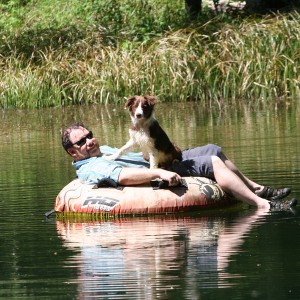 to train a dog to walk at your left side, the elegance lies in training a dog to do so with enthusiasm and joy.
to train a dog to walk at your left side, the elegance lies in training a dog to do so with enthusiasm and joy.